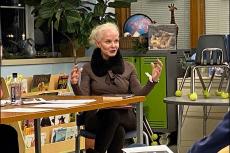“Sam is the money finder,” Councilwoman Cate Rogers joked at Tuesday’s East Hampton Town Board work session, after Samantha Klein, the town intergovernmental relations coordinator, announced the town’s eligibility for a $100,000 grant from the New York State Energy Research and Development Authority, based on its work with the Clean Energy Communities program.
“The money can be used on certain preapproved projects,” Ms. Klein told the board. “I wanted to start a conversation on how we might use that funding.”
NYSERDA’s program encourages municipalities to take certain “sustainability actions” that earn them points. Once certain point thresholds are reached, the town can receive grants, which can be used to invest in more sustainability, creating a positive cycle.
Grants are issued on a first-come-first-served basis. “As long as you do the action items and submit the documents, you get approved,” Ms. Klein said, but the grants do dry up as municipalities apply for them.
She explained that the town had already completed a number of these actions, but three recent actions, in particular, elevated the town to “three-star status,” which made it eligible for the new grant. An installation of solar panels at the Parks Department — “that got us a lot of notice because it was the first solar and battery storage on a municipal building on Long Island” — the conversion of the town’s streetlights to LED technology, and its purchase of two electric pickup trucks in the last year pushed it over the top.
The $100,000 grant is a no-match grant. “We don’t have a local cost share,” Ms. Klein said.
“Can we call that free money?” Supervisor Kathee Burke-Gonzalez quipped.
There were contingencies: The town needs to submit its application before Oct. 23, and any project funded needs to be started within three months of receiving the money and completed within three years. It could be used to buy more electric vehicles or charging stations, or go toward solar projects, energy studies of buildings, electric leaf blowers, or other electric lawn equipment.
“I spoke with the Parks Department. Just because of the amount of properties they maintain, they go through a lot of equipment. That could be a good use there,” Ms. Klein said. “The more we’re doing, the more money that’s coming in, and we spend it right back into the program’s initiatives and purposes.”
“Being able to get these designations is important,” Ms. Rogers said. “It not only fortifies our commitment to the transition to renewable energy, but it also brings us funding, which we always need to help do these projects, without impacting our taxpayers.”
“Personally, what I would like to see is it spread out, so the general public sees this grant being used, instead of, say, in just one heat pump,” Councilman David Lys said.
Ms. Klein has been busy. The previous week, she told the board about an opportunity that came to the town through participation in the state’s Climate Smart Communities program. Researchers at Clarkson and Northeastern Universities are developing “neighborhood scale” models that can project the impacts of climate hazards and change. The town already has some specific data, from the studies of the shoreline by the Dewberry consulting company and from work done during the development of the Coastal Assessment Resiliency Plan.
“In the time since those projects, we have experienced drought, heavy rainfalls, and our forests, which were healthy, now have insect infestation issues,” she said. “Due to all these different events, we want to make sure we are taking these opportunities to get the most data that we can, and the best available data.”
Andrea Ferro, a professor from Clarkson, said the work was eligible for a grant from the National Science Foundation, but the university needed a municipal partner to move forward. “They want to make sure modeling advancements are being done to support the work being done at the municipal level,” she said. Current models look at Long Island as a single data point, or region. The new models are more specific, down to a one-kilometer grid size.
Ms. Ferro said it could take months before it was known if the program received funding, but in the meantime the town could speak with researchers to identify hazard areas. “We can have these conversations and hope to get to know you better.”



